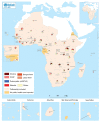Measuring Timeliness of Outbreak Response in the World Health Organization African Region, 2017-2019
- PMID: 33079032
- PMCID: PMC7588517
- DOI: 10.3201/eid2611.191766
Measuring Timeliness of Outbreak Response in the World Health Organization African Region, 2017-2019
Abstract
Large-scale protracted outbreaks can be prevented through early detection, notification, and rapid control. We assessed trends in timeliness of detecting and responding to outbreaks in the African Region reported to the World Health Organization during 2017-2019. We computed the median time to each outbreak milestone and assessed the rates of change over time using univariable and multivariable Cox proportional hazard regression analyses. We selected 296 outbreaks from 348 public reported health events and evaluated 184 for time to detection, 232 for time to notification, and 201 for time to end. Time to detection and end decreased over time, whereas time to notification increased. Multiple factors can account for these findings, including scaling up support to member states after the World Health Organization established its Health Emergencies Programme and support given to countries from donors and partners to strengthen their core capacities for meeting International Health Regulations.
Keywords: Integrated Disease Surveillance and Response strategy; WHO African Region; WHO Health Emergencies Programme; World Health Organization; communicable diseases; disease outbreaks; foodborne diseases; internally-displaced populations; outbreak response; refugee populations; time to control; time to detection; time to notification; vaccine-preventable diseases; vector-borne diseases; waterborne diseases.
Figures


References
-
- World Health Organization Regional Office for Africa. WHO African Region country offices [in French] [cited 2019 Feb 17]. https://www.afro.who.int/countries
-
- World Health Organization. The African regional health report: the health of the people. 2017. [cited 2019 Feb 13]. https://www.who.int/bulletin/africanhealth/en/
-
- Impouma B, Archer BN, Lukoya OC, Hamblion EL, Fall IS. World Health Organization Regional Office for Africa weekly bulletin on outbreaks and other emergencies. Emerg Infect Dis. 2018;24:1394–5.
-
- World Health Organization Regional Office for Africa. WHO Health Emergencies Programme [cited 2019 Apr 16]. https://www.afro.who.int/about-us/programmes-clusters/who-health-emergen...
Publication types
MeSH terms
LinkOut - more resources
Full Text Sources

